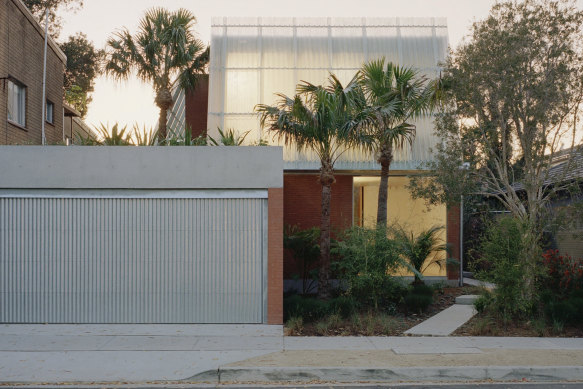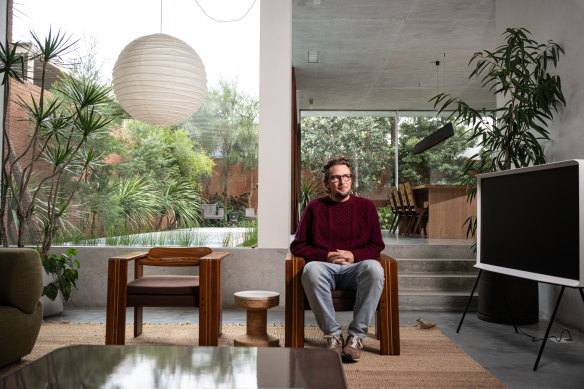From sheds and chook pens to the unlikely star of an $11 million Bondi home
By Julie Power
Translucent fibreglass sheeting that sells for $25 a linear metre is unusual in architect-designed homes. Sheds? Of course. Back patios? Bring it on. Chook pens? Cluck yeah.
But at North Bondi’s Clifton House, this inexpensive suburban material is the star. Its translucency turns the home into a lighthouse at night, and it shields the rooftop gardens and an outdoor ice bath from neighbours and clients at next door’s nail bar.

Clifton House in North Bondi designed by Anthony Gill Architects has been shortlisted for this year’s NSW Architecture Awards’ best new house. It is shielded in inexpensive fibreglass sheeting.Credit: Rory Gardiner
Described by its architect Anthony Gill as “just a Bondi red brick”, the home sold for $10.7 million a fortnight ago. Shortlisted for best new home in the 2024 NSW Architecture Awards, it is a big result for a house that wasn’t built for resale and took risks with unconventional materials.
Gill’s own home, which won the NSW chapter of the Australian Institute of Architects’ highest award for alterations and additions in 2022, was a testing ground for many of the features in Clifton House.
At 350 square metres, Clifton House is three times the size of Gill’s home and was done on a much bigger budget. But both open to the street, feature outdoor baths and use some sort of shielding that allows light to spill onto otherwise dark streets, where curtains and shutters are closed at night.
“Glowing, glowing, the rest is all darkness,” said Gill of his home. “Personally, I think privacy is overrated, and I like a bit of exposure on the living level.”
The project was the result of a long relationship between Gill’s practice, Anthony Gill Architects, and a builder, the client, Bill Clifton, the managing director of Robert Plumb Build.
That meant the two were willing to experiment with materials like the fibreglass, and reuse the bricks and Oregon timber from the original home.
Gill said it did not matter what a material cost or how it was commonly used. “If it does what we want, and we see a beauty in it ... it is really about that combination.”
“It is a brave client that goes for super knotty timber,” Gill said of Clifton’s reuse of the Oregon.
Clifton, in turn, had faith in Gill and the process. “I didn’t have to have my arm twisted because I’m always up for something different. Once you get the sun shining, what was really amazing to me is how beautiful it was from the inside,” he said.
Comments from locals weren’t always as positive. People asked Clifton if the fibreglass was temporary. “They said, ‘What are you doing?’ and ‘Geez, that’s ugly,’ etc. But once all the landscape went in and everything was finished, they understood it and liked it.”
The reason so many homes designed by architects for their own families win awards is because they are free to experiment.
That was also the case for Clifton. He had expected to live for decades in the house with his wife and three children, and also trusted his architect.
“We’ve built over 150 architectural houses now, and what I see a lot is that the client can sometimes make some bad decisions because they don’t have the experience, and push the architect in a direction that probably isn’t best for the project.”

Architect Anthony Gill at Clifton House which sold last month. It is also shortlisted for a NSW Architecture Award to be announced at the end of this month.Credit: Nick Moir
He decided to sell after an unsolicited offer prompted him to list the property. “We’re sad to be moving. For us, it was an affordability thing.” Clifton was raised on a farm and wanted to buy a property to teach his children how to fix fences, herd cattle and plant trees.
For Gill and Clifton, it’s another example of the tradition of experimentation in new homes that can often pay off in awards and clients.
Adam Haddow, a director of SJB and the president of the NSW Institute of Architects, said designing his own home – which won the highest award for new homes last year – meant he got to do things without having to convince anyone.
He gets at least five calls a week from potential clients asking if he will design something similar to the small home in Surry Hills. It is a 69-square-metre home on a 30-square-metre footprint and only 3.2 metres deep from front to back wall.
“Some are realistic, others don’t understand the nuance of getting a house like ours built,” Haddow said. The good thing was that people were starting to realise “less can be more”, he said.
Gill said designing his own home had allowed him to be braver and bolder. “When you are doing your own home, you can be a bit more daring, and less worried about resale and things like that.”
Julie Power is a lay juror on the NSW Architecture awards for new houses. The winners will be announced in late June.
Start the day with a summary of the day’s most important and interesting stories, analysis and insights. Sign up for our Morning Edition newsletter.